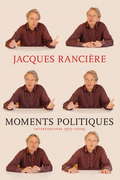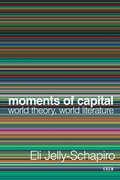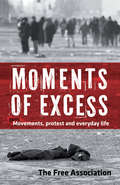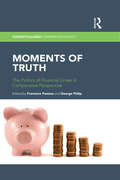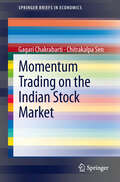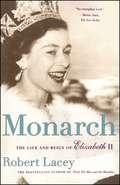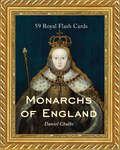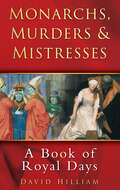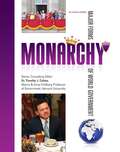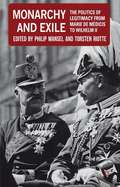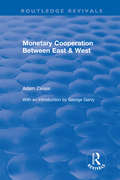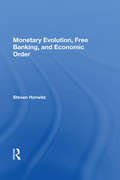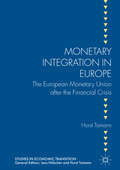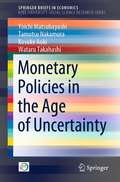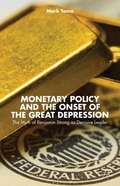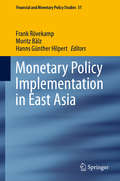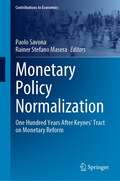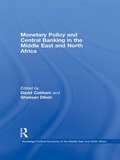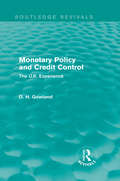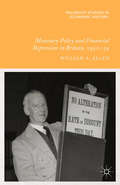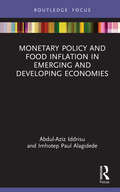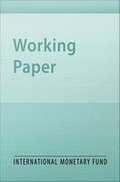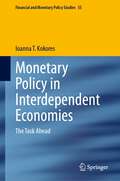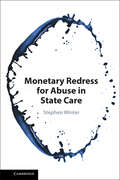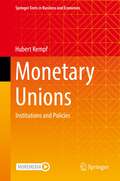- Table View
- List View
Moments Politiques
by Jacques Ranciere Mary FosterHow do we define politics? What is our role in the unfolding of the political?Moments Politiques finds Jacques Rancière, the legendary French philosopher, addressing these questions in essays and interviews drawn from thirty years of passionate public discourse. Reflecting on events from the Paris uprisings of May 1968 to the near present, and on his contemporaries including Michel Foucault, Guy Debord, and Roland Barthes, Rancière interrogates our understanding of equality, democracy, and the shifting definition of communism today.In these short, provocative, accessible pieces, we are asked to imagine a society where the "anarchic bedrock of the political" is precisely "the power of anyone." This is a world of radical equality. It is a place where the student or factory worker's opinion is equal to that of any banker or politician. To support these ideas, key concepts of Rancière's political thought are introduced, such as his notions of dissensus and political performance, and his special definition of "police." Moments Politiques stages unflinching confrontations with immigration law, new waves of racism, and contemporary forms of intervention. As ever, Rancière leads by example and breathes life into his argument that "dissent is what makes society liveable."From the Trade Paperback edition.
Moments of Capital: World Theory, World Literature (Currencies: New Thinking for Financial Times)
by Eli Jelly-SchapiroUndertaken at the interface of critical theory and world literature, Moments of Capital sets out to grasp the unity and heterogeneity of global capital in the postcolonial present. Eli Jelly-Schapiro argues that global capital is composed of three synchronous moments: primitive accumulation, expanded reproduction, and the "synthetic dispossession" facilitated by financialization and privatization. These moments correspond to distinct economic and political forms, and distinct strands of theory and fiction. Moments of Capital integrates various intellectual traditions—from multiple trajectories of Marxist thought, to Weberian inquiries into the "spirit" of capitalism, to anticolonial accounts of racial depredation—to reveal the concurrent interrelation of the three moments of capital. The book's literary readings, meanwhile, make vivid the uneven texture and experience of capitalist modernity at large. Analyzing formally and thematically diverse novels—works by Fiston Mwanza Mujila, Marlon James, Jennifer Egan, Eugene Lim, Rafael Chirbes, Neel Mukherjee, Rachel Kushner, and others—Jelly-Schapiro evinces the different patterns of feeling and consciousness that register, and hypothesize a way beyond, the contradictions of capital. This book develops a new conceptual key for the mapping of contemporary theory, world literature, and global capital itself.
Moments of Excess: Movements, Protest and Everyday Life
by The Free AssociationExamining the complicated and sometimes controversial history, goals, and tactics of anticapitalist movements, this compilation focuses on the meaning of the movement as a whole and examines the protests that surrounded global trade and political conferences such as the 1999 World Trade Organization meetings in Seattle and the ongoing G8 summits around the world. The collection offers a broad vision of anticapitalist activism as well as strategies for instigating change, not only for the individual, but also for the collective. Featuring popular culture references, humor, poetry, and essays, this analysis of the counter-summit movement is ideal for those wanting to explore new possibilities for mobilization in the midst of crisis.
Moments of Truth: The Politics of Financial Crises in Comparative Perspective (Conceptualising Comparative Politics)
by George Philip Francisco PanizzaThe current financial and sovereign debt crisis of the European Union and the United States can be regarded as the most recent of a wave of financial and sovereign debt crises that have affected different regions of the world over the past quarter century. While there is a large and growing body of literature on the economic aspects of financial crises, its political elements remain surprisingly under-studied. Moments of Truth: The Politics of Financial Crises in Comparative Perspective fills this gap in the literature by looking at the political repercussions and policy implications of financial crises in comparative perspective, using case studies in Latin America, Korea, and Russia, as well as the contemporary crises in the US and in key European countries. Contributors to this volume look at the crises as critical junctures that generate high levels of uncertainty while calling for decisive action. The chapters emphasize structural or agency based explanations and give relevance to the role of ideas, interests, and institutions in explaining different outcomes. The questions addressed by the case studies include: how the crises were defined by key actors, the range of political and policy options available to deal with their impact, the role of ideas in policy shifts, how political and economic actors redefine their interests in contexts of uncertainty, how political institutions mediate reactions to the crises, what explains the choice of a certain option over other alternatives, and whether the crisis has (so far) resulted in significant political and policy changes or in incremental adjustments to the status quo. The first book to comparatively analyze the political dimensions of financial crises across different global regions, Moments of Truth will be highly significant for any scholars interested in the contemporary debate on financial crises.
Momentum Trading on the Indian Stock Market
by Chitrakalpa Sen Gagari ChakrabartiThis study is an exploration of the Indian stock market, focusing on the possible presence of momentum trading. One thing, however, should be noted. While it is true that momentum trading, which tends to generate speculative bubbles, may result in a financial market crash, its nature in contrast might depend on the nature of the economy itself. The study, while exploring the presence and nature of momentum trading on the Indian stock market in recent years, seeks to relate it to significant structural breaks in the Indian or global economy. To be precise, it outlines a potential correlation between the instability in the stock market and the speculative trading on the market, exploring the question of whether it is human psychology that drives financial markets. In the process, the choice of a significant structural break has been obvious: the global financial meltdown of 2007-2008 - a crisis that has often been referred to as the worst ever since the crash of 1929. While analyzing the nature of momentum trading on the Indian stock market with regard to the financial crisis of 2007-08, the study takes into account two major representatives of the market, the BSE (Bombay Stock Index) and NSE (National Stock Index), for the period 2005 to 2012. This study seeks to answer a few important questions. First of all, it tries to unveil the underlying structure of the market. In doing so, it examines the following issues: (i) What was the latent structure of the Indian stock market leading up to the crisis of 2007-08? Does the structure offer insights into designing profitable trading strategies? (ii) Is it possible to construct a profitable portfolio on the Indian stock market? (iii) Is there any profitable trading strategy on the Indian stock market? While exploring these issues, the study delves deeper, breaking the whole period down into two sub-periods, before the crisis of 2008 and after the crisis. The purpose of this division is to determine whether there has been any discernible change in the market structure since the shock.
Monarch: The Life and Reign of Elizabeth II
by Robert LaceyFor more than fifty years, Elizabeth Alexandra Mary Windsor-- who became Elizabeth II, Queen of England on February 6, 1952-- has been loved and loathed, revered and feared, applauded and criticized by her people. till she endures as a captivating figure in the world's most durable symbol of political authority: the British monarchy. In Monarch, a meticulously detailed portrait of Elizabeth II as both a human being and an institution, bestselling author Robert Lacey brings the queen to life as never before: as baby "Lilibet" learning to wave to a crowd in the Royal Mews; as a child "ardently praying for a brother" so as to avoid her fate; as a young woman falling in love with and marrying her cousin Philip; and as the mother-in-law of the most complicated royal of all, Princess Diana. Updated with new material to reflect the 2002 Golden Jubilee and the passing of the Queen Mum -- and featuring dozens of photographs, a family tree of the Hanoverian-Windsor-Mountbatten families, and a map that charts the location of royal castles-- Monarch is an engaging, critical, and celebratory account of Elizabeth's half-century reign that no reader of popular history should be without.
Monarchs of England: 59 Royal Flashcards
by Daniel ChalkeRoyal portraits and fast historical facts on rulers from King Athelstan to Queen Elizabeth II. Whether famed like Queen Victoria or a bit more obscure like King Sweyn Forkbeard, this collection tells a story that spans more than a thousand years, showcasing the fifty-nine English monarchs who preceded King Charles. It features portraits from prestigious galleries like the National Portrait Gallery in London, each a beautiful, miniature work of art set in an elegant gilt frame, paired with fascinating details of the monarch&’s reign. Perfect for reference, study, or an entertaining browse through history, Monarchs of England makes learning about the English monarchy a visual treat.
Monarchs, Murders and Mistresses: A Book of Royal Days
by David HilliamWhich 'ill-prepared' monarch was on the English throne at the turn of the last millenium? How many English monarchs have been crowned on St George's Day? When, how and why did England 'lose' eleven days? "Monarchs, Murders & Mistresses" answers these questions and many more, presenting a royal event for each day of the calendar year in vivid detail with close-ups of the personalities involved. The book reveals the recurring occupational difficulties faced by the royal family over the centuries: as Shakespeare's Henry VI so memorably concludes. 'Uneasy lies the head that wears a crown'. Today the royal family is plagued by the press, but even 300 years ago Charles II felt the need to apologise to a crowd of onlookers for taking so long to die. this book contains topics ranging from the death of William III, who was killed by a mole to the beheading of Mary, Queen of Scots. These, and over 400 other tales of royal days, bring alive the drama of what it was, and is, to be a king or a queen.
Monarchy (Major Forms of World Government)
by Leeanne GelletlyMonarchy is a form of government in which a hereditary ruler serves as head of state, typically for life. Monarchies have existed since the dawn of human civilization. But while the kings and queens, emperors and empresses of the past wielded broad (and often absolute) power, many of today's monarchs perform ceremonial functions only. This book examines the various forms that monarchy has taken. Students of government and history will find it a valuable and fascinating resource.
Monarchy and Exile
by Philip Mansel Torsten RiotteUsing detailed studies of fifteen exiled royal figures, the role of Exile in European Society and in the evolution of national cultures is examined. From the Jacobite court to the exiled Kings' of Hanover, the book provides an alternative history of monarchical power from the 16th to 20th century.
Monetary Cooperation Between East and West (Routledge Revivals)
by Adam ZwassThis title was first published in 1975:
Monetary Evolution, Free Banking, And Economic Order
by Steven HorwitzThis book deals with the origin and functions of money and banking, emphasizing the role both play in the promotion of economic order. Developing the insights of Hayek and others of the Austrian tradition, Professor Horwitz argues that an appreciation of the spontaneous evolutionary processes that produce and maintain our monetary institutions shou
Monetary Integration in Europe
by Horst TomannThis book depicts the European Economic and Monetary Union against the historical background of different monetary regimes and pays special attention to the economic debate which accompanied the evolution of this currency area. The debate is still going on as to whether the European Economic and Monetary Union can survive as an institution providing the highest degree of monetary integration - a single monetary policy - for a group of member countries with divergent economic performance. The analysis of this question points at the need for new forms of economic policy coordinaton. This book explores the problems of policy coordination that arise within a monetary union and provides an overview of the basic issues and current controversial debates. The book is an excellent resource for academics with an interest in the European Economic and Monetary Union, and in economic policy coordination within Europe.
Monetary Policies in the Age of Uncertainty (SpringerBriefs in Economics)
by Tamotsu Nakamura Yoichi Matsubayashi Kosuke Aoki Wataru TakahashiThis book provides an interesting review of Japanese monetary policies after the bubble economy. The Bank of Japan was the first central bank in advanced economies to implement the unconventional monetary policies during the period. After the Lehman shock, most advanced economies also carried out similar monetary policies to boost their own economies. The Japanese experience in the 1990s and 2000s no doubt played a key role during the period. Although various aspects of the experiences have been examined, not many books have been published based on intensive discussions between the macro and monetary theorists who have been active in academics and the practitioners who have actually been involved in monetary policy. This small but important book has focused on the Japanese experience. Evaluation of that experience found that three solid pillars are of crucial importance: theory, institution, and experience. Those form the basis of the book, without theory, no policies will be formulated and implemented, and implementation depends crucially on institution. Chapter 1 provides a clear theoretical background for the unconventional monetary policies and inflation targeting. Chapter 2 intensively explores the meaning and desirability of the independence of central banks. Chapter 3 reviews the consequences of the Japanese monetary policies in recent decades in comparison with those in other advanced economies.
Monetary Policy And The Onset Of The Great Depression The Myth Of Benjamin Strong As Decisive Leader
by Mark TomaMonetary Policy and the Onset of the Great Depression challenges Milton Friedman and Anna Schwartz's now consensus view that the high tide of the Federal Reserve System in the 1920s was due to the leadership skills of Benjamin Strong, head of the Federal Reserve Bank of New York.
Monetary Policy Implementation in East Asia (Financial and Monetary Policy Studies #51)
by Frank Rövekamp Moritz Bälz Hanns Günther HilpertThis book shares essential insights into the implementation of monetary policy in various East Asian countries. Highlighting case studies from China, Taiwan, Korea, Japan and Singapore, leading economists and practitioners from central banks illustrate how dependent effective monetary policy is on the institutional and financial market environment, as well as on successful implementation and communication. The respective contributions cover various aspects of monetary policy implementation, such as: How is inflation targeting handled? For what purposes and how do central banks operate on financial markets, and what are the (at times unintended) effects? How do currency market interventions help achieve the monetary policy targets set by individual countries or areas? In addition, Asian experiences are contrasted with those from the Eurozone.
Monetary Policy Normalization: One Hundred Years After Keynes' Tract on Monetary Reform (Contributions to Economics)
by Paolo Savona Rainer Stefano MaseraIn light of the pickup of inflation at the end of 2021 and monetary policy shifts by the world's major central banks, this book examines interrelated issues in the normalization of monetary policy. It covers topics including the role of technological innovations such as derivatives and cryptocurrencies in monetary and financial management, the role of monetary policy in financial crises (especially public debt), and the major repricing needed for central banks and the global economy. In addition, the book discusses the problem of how flexible money should be and the importance of predictive tools for these decisions, with attention to the advances of languages for scientific research, including those on the workings of the economy. The work addresses the geopolitical and social challenges that have arisen as a result of the invasiveness of monetary policy in its various manifestations in the context of major leading currencies. It is aimed at scholars and students of monetary and financial economics.
Monetary Policy and Central Banking in the Middle East and North Africa (Routledge Political Economy of the Middle East and North Africa)
by David Cobham Ghassan DibehThis book examines monetary policy, central banking and exchange rate regimes in the Middle East and North Africa. Part I covers central banking and monetary policy, while Part II covers monetary policy and exchange rate regimes. Some chapters focus on the monetary frameworks of particular countries, including Lebanon, Algeria, Syria, Tunisia, Morocco, and Turkey, outlining the different systems operated in each case, considering their successes and failures, and discussing important issues such as government policy, macroeconomic performance, inflation and inflation targeting, central bank independence and the impact of broader political economic developments on the conduct of monetary policy. Other chapters cover thematic issues across the whole region, including: central bank independence, operations of debtor central banks, the effect of exchange rates on inflation, and the effect on countries’ trade of alternative exchange rate regimes. Drawing on the insights of scholars and policy-makers, this book is a vital resource for anyone wanting to understand the economies of the Middle East and North Africa.
Monetary Policy and Credit Control: The UK Experience (Routledge Revivals)
by David H. GowlandThis book, first published in 1978, provides an analysis of British monetary policy and considers what techniques of monetary control were most appropriate to the context of the U.K. during the 1970s and 1980s. David Gowland answers crucial questions surrounding economic management in the period between 1971 and 1976, in particular whether rapid monetary expansion was the cause of the acceleration of U.K. inflation. With an analysis of the government’s experimentation with policy at its core, this is a unique study which will be of interest to students of monetary policy and recent British economic history.
Monetary Policy and Financial Repression in Britain, 1951–59
by William A. AllenBritish monetary policy was reactivated in 1951 when short-term interest rates were increased for the first time in two decades. The book explores the politics of formulating monetary policy in the 1950s and the techniques of implementing it, and discusses the parallels between the present monetary situation and that of 1951.
Monetary Policy and Food Inflation in Emerging and Developing Economies (Routledge Focus on Environment and Sustainability)
by Abdul-Aziz Iddrisu Imhotep Paul AlagidedeThis book focuses on the impact of monetary policy and food price volatility and inflation in emerging and developing economies. The tendency for food price volatility to blot inflation forecasting accuracy, engender tail dynamics in the overall inflation trajectory and derail economic welfare is well known in the literature. The ability of monetary policy to exact stability in food prices, theoretically, has also been well espoused. The empirical evidence, however, is not only in short supply, but also the studies available have dwelt on approaches that underplay the volatile behaviour of food prices. This book focuses on inflation targeting in emerging economies such as Chile, Mexico, Turkey, Brazil, Hungary, Russia, Colombia, South Africa, Indonesia and Ghana, as these are economies with considerable proportion of the consumption basket occupied by food. The book provides the means to understand at first hand the correct way to model food inflation, account for the related policy responses to deviations either in the short or medium to long term, and in market conditions that are subject to excessive variability. Strong evidence is presented that captures deviations of food prices from their trend and the accompanying monetary policy effect in stabilizing such variabilities across distinct frequencies. The novel approach in this book addresses the burgeoning puzzles of asymmetry in monetary policy effect on food prices at high, medium and low episodes of food inflation. In doing so, this book presents a powerful tool for researchers interested in understanding not just the transmission mechanism, but also the magnitudes involved, and to policymakers whose existing tools have failed them. Future studies will do well to deepen the evidence and seek new grounds to which the phenomenon manifests beyond and below emerging markets. This book will be of great interest to students, scholars and policymakers involved in agricultural economics, financial economics, food security and sustainable development.
Monetary Policy and the Lost Decade: Lessons from Japan
by Daniel LeighA report from the International Monetary Fund.
Monetary Policy in Interdependent Economies: The Task Ahead (Financial and Monetary Policy Studies #55)
by Ioanna T. KokoresThis book explores the challenges faced by central banks in the aftermath of the global financial crisis and the events that followed. It further emphasises the asymmetries in the transmission of monetary policy in the Eurozone economies and among major advanced economies. The book also highlights the advances in the monetary policy debate towards an efficient resource allocation.The author argues that the canonical model of macroeconomic stabilization, which assigns the main burden of stabilization to monetary policy, is outdated primarily because of the absence of financial frictions. Further, she highlights the urgency of pushing risky activities outside the perimeters of regulation in face of rapidly evolving financial markets. The book provides an analytical framework in the context of intense globalisation and increased interdependence across economies, irrespective of the recent re-examining of supply-chains and trade relationships, as well as a policy framework thoroughly amended after the global financial crisis and the crises that followed it.Presenting policy proposals, the book discusses how policymakers must try to develop a set of policies that the public will have confidence in and take into account in forming expectations about future inflation and spending. It will be useful to central banking practitioners, monetary and fiscal policymakers, as well as students and scholars in economics and, in particular, financial economics.
Monetary Redress for Abuse in State Care
by Stephen WinterInvestigating a fast-developing field of public policy, Stephen Winter examines how states redress injuries suffered by young people in state care. Considering ten illustrative exemplar programmes from Australia, Canada, Ireland, and Aotearoa New Zealand, Winter explores how redress programmes attempt to resolve the anguish, injustice, and legacies of trauma that survivors experience. Drawing from interviews with key stakeholders and a rich trove of documentary research, this book analyses how policymakers should navigate the trade-offs that survivors face between having their injuries acknowledged and the difficult, often retraumatising, experience of attaining redress. A timely critical engagement with this contentious policy domain, Winter presents empirically driven recommendations and a compelling argument for participatory, flexible, and survivor-focussed programmes.
Monetary Unions: Institutions and Policies (Springer Texts in Business and Economics)
by Hubert KempfThis textbook explains the notion of monetary union, highlighting the key concepts, procedures, and challenges involved. The book is organized in three parts. In the first part, the reader learns about monetary issues, like definitions and typology of monetary unions, rationale of monetary unions, monetary policy, monetary institutional matters. The second part is devoted to fiscal matters and the interplay between fiscal and monetary policies, such as deficits, transfers, public debt sustainability issues, fiscal policy, policy mix. The last part focuses on other distinct but related issues, necessary to complete the union: banking and fiscal unions, structural adjustments in a monetary union. It ends with a chapter on the fate of monetary unions: how they develop, mature and sometimes dissolve.The book addresses students at undergraduate and graduate level, interested in a better understanding of international macroeconomics and monetary unions, as well as policy-makers, practitioners and economists in central banks, ministries of economics, economic institutions and banks.
